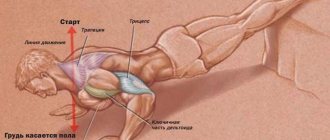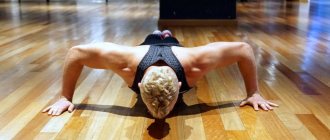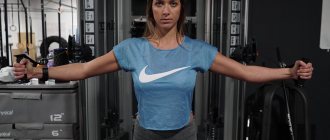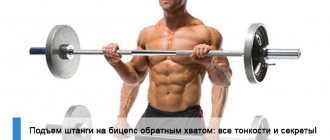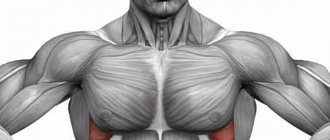What do push-ups do?
Push-ups help pump up your back, chest, shoulders and biceps
. By performing a standard exercise, a person puts a good load on the muscles of the back, chest, arms and even the core. At the same time, the effect of training depends on the width of the arms, the number of approaches per set, and the regularity of training.
Basically, when doing push-ups, the pectoralis major muscle works, especially its sternocostal part. But by spreading his arms wider, the man manages to use the small one.
If you regularly do push-ups to pump up your pectoral muscles and arms, you can get the desired shape and get rid of excess weight. Because such workouts burn a lot of calories.
What are the muscles in the chest
The pectoral muscles are also called pectoral muscles. They consist of a group of symmetrical muscles. Each such group includes the following muscles:
- Large chest.
- Small chest.
- Anterior serratus.
The first two muscles are responsible for allowing a person’s arms to bend at the shoulder joint. In addition, thanks to them, the arms are partially rotated inward. The human chest can be divided into several sections, which include the upper, middle and lower sections. In addition, there is also an internal part. She can also be pumped up.
The muscles in the middle section are always actively working and therefore pump up quite quickly. But the lower and upper parts of the chest require a special approach. Targeted training is important here to help pump up the chest in these parts.
Training the pectoral muscles itself is very energy-intensive, so many people also use it to burn excess fat.
Important Rules
Warm up before exercise
In order for classes to be more effective, it is important to adhere to the following recommendations from professionals:
- Before any strength exercises, it is necessary to warm up. Light stretching will also be beneficial for your muscles. Such 10-15-minute warm-ups prevent injuries to joints and tendons. Additionally, they protect muscles from sprains.
- When doing regular strength training, you need to eat right. In order to notice a noticeable increase in muscle mass, it is important to focus on protein foods.
- The main principle of training is overcoming resistance. When the load already seems light, 30-40 push-ups are very easy to do, it’s time to increase the number of repetitions. Otherwise, the muscles will not work at full strength.
- Pain is a sign of improper home workouts. Overloaded muscles do not grow, but rather become deformed. Therefore, you should not be too zealous. The body needs time to recover. Listen to your body.
- Be sure to train comprehensively. Well-pumped pectoral muscles and weak cores are the cause of stoop. Therefore, work on your back and abdominal muscles.
- Start training with a small number of approaches, always doing one rep more than you think you can squeeze out.
- Pay attention to the fact that pumped pectoral muscles shorten. This causes disproportion between different parts of the back. To prevent this from happening, work on stretching after your workouts. Muscles must be not only strong, but also elastic.
The training program must include rest days. The body must constantly and well recover. Then push-ups will be useful.
Types of exercises
To work the upper pectoral muscles, you can perform a simple set of exercises.
Pectoral push-ups for men
Push-up technique
This exercise can be difficult for beginners. Therefore, at first you can do push-ups on your knees. You need to do 10-15 push-ups in one approach. Break 1 minute. Next you need to continue and do another approach.
When performing the exercise, the lower back does not bend in one direction or another. If you feel a lot of strain on the muscle on the left or right, try moving one hand forward/back a little.
Upside down push-ups
Vertical push-ups
Often, experienced athletes prefer to perform seated barbell presses to pump up the upper part of the pectoral muscle. But at home, such an exercise can be replaced with simple push-ups with your head down. The legs should be higher than the hips and head. In this position, the delta bundles and clavicular area are well worked out.
To create maximum stress on the muscles, you can rest your feet against the wall.
Narrow push-ups
If you connect your hands under your chest and do push-ups in this position, you can work the inside of your chest. The position of the limbs in this exercise is such that the elbows are along the entire line of the shoulders, and the fingers of both hands lightly touch each other. We need to emphasize this. At the moment of lowering, you should touch your chest to your hands. And before rising, you need to pause for a second. A detailed description of the exercise allows you to perform it as correctly as possible.
Bench push-ups
Push-up technique with hands on a bench
To increase the load on the middle areas of the pectoral muscle, you can use two stools. They are placed on either side of you approximately shoulder width apart. It is worth considering that the legs should be located on a different elevation. Push-ups are performed in such a way that the body is in a static position as much as possible when lowering down. It is advisable to perform 3-4 sets of 10-15 times. Between them take a break of 2-3 minutes. A sculpted torso is guaranteed from such training.
Forward Bend Exercises
The load will be placed on the upper and lower pectoral muscles. The technique for performing the exercise is to keep your legs above shoulder level. They can be placed on an armchair or sofa. Your palms should be placed wider than your shoulders.
When doing push-ups, always try to keep your elbows out to the sides. It is this position that allows the pectoral muscles to be well pumped, and not the triceps. If you additionally place the brushes at an angle of 45°, you can also pump up the wings.
Circular push-ups
Circular push-ups
The exercise pumps up the muscles of the back and abdomen in the middle, triceps, deltoids and sternum (top/bottom). Starting position – emphasis “lying” on the feet and hands. Your palms should be positioned wider than your shoulders. The reference point is the level of the heart. Perform push-ups so that when lowering, the load rolls from one hand to the other, that is, the body makes a circle. At the exit, the body is lifted up. The movement of the body should be changed every 10 push-ups. First one way, then the other. It is important to breathe evenly and calmly.
If you don’t know how to do this exercise correctly, you should take a couple of lessons from an experienced trainer.
How to pump up your lower chest
While paying attention to the upper and middle sections of the pectoral muscle, we should not forget about the lower chest. It is more difficult to pump than other departments and requires a specialized approach to exercises
It is more difficult to pump than other departments and requires a specialized approach to exercises.
Pump up your lower chest
You can use the usual bench press and dumbbell bench press with a reverse incline. Your workout should include exercises such as pullovers and dips.
Instructions
Helpful advice!
The bench press is a basic exercise for working the pectoral muscles. It can be performed with a medium, narrow and wide grip, on a horizontal bench, on a bench with an incline up and with an incline down. To pump up the lower chest
, you need to do a bench press with a wide grip on a bench with a downward inclination of 35-45 degrees.
To perform the incline press, you will need the help of a partner to lift the barbell with you and put it back on. Doing this exercise on your own is risky. If you don’t have a specialized bench for reverse pressing, then an incline bench for pumping your abs will do.
It is important to have a footrest. You should not slide while performing the press.
As you inhale, lower the barbell to your chest
closer to the solar plexus.
Spread your elbows to the sides, making a cross in relation to your body. Try not to press them closer to you. This will transfer the load to your triceps. After touching your chest
, press the barbell upward as you exhale.
The incline dumbbell bench press is performed in a wide arc to maximize the use of the pectoral muscles and isolate the work of the triceps. Overhead grip of dumbbells. In the starting position, the dumbbells are directly above you, with the discs touching each other. As you inhale, spread the dumbbells to the sides. Extend your elbows into a cross, as in a bench press. On exhalation - i.p.
The pullover does not pump up the chest, but helps expand the volume of the chest and visually enlarge it. It is done with light weight 8-10 times until you feel a stretch in the ribs. Performed on a flat horizontal bench with dumbbells. Lie on your back with your head at the edge of the bench. Hold the dumbbell with both hands near your stomach and lower chest
.
As you inhale, lift the dumbbell behind your head. As you exhale, return to IP. You can also perform a pullover across the article, leaning on it only with your shoulders. It is better to do pullovers before the bench press, and dips after it.
note
This is the first exercise that will allow you to pump up huge pectoral muscles, subject to regular progression of weights. The first thing you should do is choose the optimal inclination of the bench - 30 degrees.
Note!
You can leave it unchanged (upward slope), or you can make it negative - then the load vector will be like in a crossover.
The more negative the angle you take, the more isolated the chest will work, the more emphasis will be on its lower part.
Helpful advice
Now that you know about anatomy and movement mechanisms, let's figure out how to pump up a wide chest. The movements and exercises presented are designed to get maximum results every time you visit the gym.
Flat bench exercises work the lower and middle portions of the pectoralis major muscle, positive incline bench work primarily targets the upper and to a lesser extent the middle portion, and negative incline bench presses work the lower...
how to pump up your lower chest
How to pump up your lower chest
Techniques for increasing the load
Push-ups with extra weight
With regular exercise, the pectoral muscle is worked quite well. However, there comes a time when a simple load is no longer enough and some additional help is required in mastering the new scheme. When a man feels that training is not giving the expected results, the following can be done:
- Use any weights. More often it is an ordinary backpack with cargo.
- Perform more approaches with fewer rest pauses.
- Do more approaches in one set. In this case, repetitions can be reduced.
- Add more complicated variations to the floor push-up program for the pectoral muscles. For example, explosive push-ups (push-ups with a clap), incline push-ups, or grip-push-ups on parallel bars.
Increasing the loads can be done by performing bench presses on the horizontal bar. Such activities further develop coordination.
Upper pectoral push-ups
Most bodyweight trainees avoid using upper pectoral push-ups, focusing on the regular version of this exercise or dips, which primarily develop only the middle and lower pecs. This can affect progress and lead to a less than aesthetically pleasing appearance. How to avoid this is further in the text.
Training program
It is important for novice athletes to understand that there is no point in training for pumping every day. Any load on the muscles leads to microtrauma. This will cause significant pain in the part of the body being worked. This means that the body and tissues need time to recover from the pump. During this time, the muscles become stronger and protein is produced, which ensures their additional growth. If you don't pay attention to the pain and exercise every day through strength and discomfort, you can get a serious sports injury. The optimal training program for a beginner is 2-3 days a week. In this case, the total number of approaches should be no more than 8. You can start by performing two or three push-ups with 2-3 repetitions for each. Gradually the load is increased, and the program is expanded with additional exercises. They can affect the growth of muscle relief.
It is advisable to gradually increase the load on the thoracic region, as the muscles get used to the work and stop progressing. Static push-ups help with this: at the lowest and middle points of the exercise you need to pause for a second. Static push-ups are performed slowly. It's hard, but effective.
Table of push-ups for one approach for athletes with different levels of training:
| Level of training | Number of push-ups per approach |
| Newbie | Up to 5 |
| Middle | 6-10 |
| Athlete | 11 times or more |
Benefits of push-ups
The result of daily push-ups for a month
Even though the exercises are done at home, they have benefits:
- No need for complex or special equipment. The workouts are done simply at home on the floor. The only important thing is the presence of 2-3 square meters of free space. A bedroom, living room or even a corridor is well suited for this.
- Push-ups work well not only the pectoral muscles, but also the back, abs, shoulders, and arms. Such elaboration is already the key to a beautiful body.
- When doing push-ups, the cardiovascular system works fully. The main muscular organ intensively pumps blood, which makes the body stronger and more resilient. As a result, a man will get colds less often.
- At the same time, such step-by-step strength training burns fat deposits. So push-ups are also suitable for those who are struggling with excess weight.
Training is carried out on an empty stomach or after a light snack. There is no need to expect quick results in a week. A beautiful body requires strength, time and perseverance.
Exercises for the chest and muscles are also recommended for girls and women. In a month of effective training you can achieve results. It's never too late to pump up your breasts.
What may be included in the training arsenal
Before you start training, remember the rule of bodybuilders: first you need to build muscle mass, and only then actively engage in its development. Below is a list highlighting the most popular and effective exercises for developing the upper chest. All of these exercises are good in their own way, and some exercises can be performed in a superset format.
Bench press. This is a classic. All chest exercises pale in comparison to its importance for the development of not only the pectoral muscles, but also all the muscles of the shoulder girdle. This exercise involves all the large muscles of the shoulder girdle (pectorals, biceps, triceps, deltoids, forearms). The back and legs are also partially involved. There are many variations of the bench press, tailored to suit different training goals and sports. Specifically, we are interested in the bench press on a regular horizontal bench with a wide grip in a bodybuilding style. This exercise is performed with free weights in the range of 8 to 10 repetitions, if we are talking about gaining muscle mass or strengthening certain muscles involved in the work. If your goal is to maintain shape or work on relief, then we recommend performing 10 to 12 repetitions per set. The number of approaches is from 3 to 4. There is another wonderful exercise that athletes call dumbbell flyes. This is also done with free weights. Its essence is to smoothly bring and spread arms straight at the elbow joints with weights in the form of dumbbells. During training, perform 12-15 repetitions of this exercise in pumping mode for three to four approaches. Incline dumbbell press. The optimal choice is considered to be an angle of inclination from 45 to 60 degrees. Do not chase heavy weights, perform the exercise with a feasible load. Increase it gradually as you adapt to the load. We lower it strictly to the top of the chest, squeeze the dumbbells straight up. We recommend performing 10 to 12 repetitions per set. The number of approaches is from three to four. Bench press on an incline bench. Same principle as the incline dumbbell press. It is optimal to choose an angle of inclination from 45 to 60 degrees. Don't chase weight, do the exercise with a feasible load. Increase it gradually as you adapt to the load
It is important to have an experienced partner who will serve and receive the barbell. If this is not done, the risk of injury increases significantly.
We lower it strictly to the top of the chest, squeeze the bar straight up. We recommend performing 10 to 12 repetitions per set. The number of approaches is from three to four. Pullover. A very common exercise for the upper pectoral muscles. With straightened arms, the dumbbell is lifted upward from behind the head. In this case, you lie on a horizontal bench. Among other things, the pullover does a very good job of stretching the pectoral muscles and can even slightly increase the volume of the chest. We recommend performing ten to twelve repetitions per set. Number of approaches – from three to four. Here it is especially important to pay attention to technique and not to chase the working weight.
Let's summarize briefly. In the arsenal of a modern bodybuilder (and even a simple physical athlete) there is a fairly large number of exercises designed to improve the upper chest. These are at least the following exercises: dumbbell press on an incline bench, barbell press on an incline bench, pullover, bench press on a horizontal bench, dumbbell flyes. With the correct technique, they will help you pump up powerful breasts, which many people will look at with envy. And remember that it is much better to train in the gym than at home. Here you will find much more motivation, equipment and support from the hardware brothers.
As usual, in the end, we wish all our readers success in the sports field, powerful muscles, good health for many years and happiness from all the sporting successes achieved. Be persistent and unbending on your path! Don't be afraid of any difficulties! But at the same time, remember that you need to approach everything wisely and as thoughtfully as possible. Don't try to break through walls with your forehead. Don’t forget about the future of your children, instill a love for sports in them from an early age, and show them a positive personal example. Believe me, then it will be too late to change anything in your life and theirs. Better start changing your life right now.
